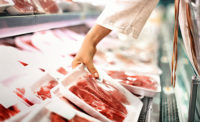With the domestic beef cattle herd expansion and steady increases in supply, the state of the beef industry is evolving and there is reason for optimism moving forward.
Drought conditions subsided across the United States and after a period of strong cattle prices, producers responded by investing in herd expansion. As this translates into increased beef production moving forward, growth in per capita consumption is expected to experience continued growth for the foreseeable future. After reaching historic lows of less than 55 pounds per capita in 2015, CattleFax, a leading beef cattle research and analytics firm, estimates consumption will approach 58 pounds per capita by the end of 2018.
Given this predicted turnaround in per capita consumption, it is important to look at where the country stands economically to more fully understand how consumers might respond to the increased availability of beef.
The recent rise in consumer confidence1 should foster an environment that could facilitate stronger beef sales moving forward. The U.S. economy is projected to grow at a moderate pace for the remainder of 2017, slowing just slightly into 2018.
Beef has remained a good value for consumers2 as prices have adjusted because of increased supply. For perspective on how beef volume moves through the channels, 2016 IRI data shows slightly more beef has been sold at foodservice for several years. In the retail channel, which accounts for just less than half of all beef pounds sold, checkoff funded research shows that when beef is purchased at the grocery store there is a considerable uptick in the value being realized by this channel. Simply put, when beef is in the shopping cart, consumers tend to purchase other items they might not otherwise select, increasing sales for retailers. For ground beef, that could include items such as seasoning mixes, cheeses and taco kits. When steak hits the shopping cart, you can expect consumers to purchase additional items such as marinades, shrimp or produce3.
The value story is somewhat similar for the foodservice channel. When a consumer orders a steak at a restaurant, the total bill tends to be greater as consumers are more likely to include an appetizer, side, beverage or dessert4. In fact, when beef is center of the plate, the overall meal profit can average as much as 25 percent more than other proteins such as fish, pork or chicken.
In addition to beef checkoff-funded research on the benefits beef brings to the channels, extensive research is also conducted on consumer attitudes about the food they purchase2. For example, research conducted by National Cattlemen’s Beef Association, a contractor for the beef checkoff, shows how well beef performs on key attributes important to consumers2. Almost 90 percent of consumers say beef is great tasting as well as a great source of protein2. Regarding beef tenderness, steak has enjoyed continued improvement over the past 25 years and has achieved its best tenderness scores since testing began in 19905. That, coupled with consumer perceptions of beef across other important factors6, is what keeps driving folks back to the meat case and out to restaurants to enjoy their favorite protein.
We also know from checkoff-funded research that consumers are very positive about beef’s taste2 but aren’t always convinced they know how to prepare certain cuts of beef6. For that reason, the beef checkoff-funded the Beef. It’s What’s for Dinner. Culinary Center, which develops and shares instructional brochures, fact sheets and videos on the BeefItsWhatsforDinner.com Web site and social media platforms to help consumers know how to select and prepare the perfect cut for the right occasion.
Consumers continue to become more health conscious and subsequently more discerning about the food they buy and feed their families2. Nutritional content is meaningful to many consumers, especially to older millennial parents6. Health claims on food packaging abound and consumers increasingly use this information to help inform their purchase decisions. While many food items claim to be a source of protein, beef has a strong nutritional profile and supports consumers’ interest in living a healthy lifestyle.
Beef checkoff-funded research also indicates that while consumers, especially Millennials, have questions about how beef is produced, the reality is they know little about what takes place on the ranch or at the feed yard6. This consumer interest in the production processes is driving the industry to become more transparent and effective at communicating how beef is raised. To help consumers know more about how the beef they buy is produced, beef checkoff-funded programs tell the story of how beef is raised in concise, clear and consumer-friendly ways.
Consumers also show a high level of interest in safety. When it comes to safety, the beef industry sets incredibly high standards for itself. To help ensure beef is being raised responsibly and safely, the Beef Quality Assurance program develops and disseminates education and training materials to help beef producers continue raising high-quality beef.
Sustainability is another topic of importance to consumers and the beef community. America’s farmers and ranchers dedicate their lives to producing nutrient-rich beef in the most sustainable way possible. According to a national survey of U.S. beef farmers and ranchers, 99.8 percent of respondents employ at least one water quality improvement practice recommended by the Natural Resources Conservation Service7. Thanks to these and other sustainability efforts, the beef community is producing more high-quality beef with fewer resources than ever before. NP
Sources:
- Copyright, 2017, Surveys of Consumers, University of Michigan. Reprinted with permission.
- 2016 Consumer Beef Index
- June 2014; IRI Fresh Meat Market Basket Analysis
- FY2017 Checkoff Foodservice Insights Report
- 2015/2016 National Beef Tenderness Study
- Consumer Beef Index 2017
- Loy, D. et al. 2017. Water Quality and Beef Sustainability. Available at: http://bit.ly/ncbaSOI17









